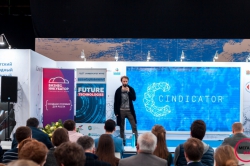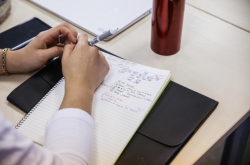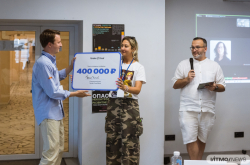You graduated from the Faculty of Physics and Engineering in 2010. Why did you choose this faculty and ITMO University in the first place?
My brother and I come from Nizhnevartovsk, and in our school there we had a special class preparing us for admissions exams to St. Petersburg’s leading universities. By this time we’d already understood that what we were really into hard sciences; moreover, our school specialized in teaching Maths and Physics. Friends and family helped us with their advice, too, as we were just 17 and had little idea of what we wanted to do career-wise.
We applied for several universities and got into ITMO in the end. We’d been studying thermophysics first, but then after 2,5 years we got bored of it and decided to transfer to the Department of Physics and Optical Communications Technology, which we ended up loving because there were different teachers, different environment and it was more interesting overall. We also started attending additional classes at the St. Petersburg State University of Telecommunications.
Did you get into business when studying at university?
More like, after. But the realization that we wanted to do something of our own dawned on us when we were in second or third year of studies. We were inspired by books, for example, ones by Robert Kiyosaki. A major influencing factor was that our father was an entrepreneur, he always worked for himself. Thanks to his example, starting our own business didn’t seem that daunting.
Lastly, people from our environment also shared this mindset, they constantly looked for opportunities to put their knowledge into practice. So, looking back, I think that we were pushed in this direction by our parents and friends.
That all led to us venturing into different business initiatives right after graduating. We began by launching a post courier service in our home town, Nizhnevartovsk. We did that for one year, then we returned to St. Petersburg and set up a flower delivery service and an online shop selling scooters.

Your first encounter with Tyvek-made accessories was during a trip to the US you went on when you were still at university. Was it back then that you got the inspiration for ‘New Wallet’?
We went to the States as part of the Work and Travel program which was recommended to us by a friend who at that point had already been to the US a couple of times. Now we ourselves always recommend Work and Travel to others as it’s a perfect opportunity to see other countries, gain some experience and meet new people. We got ready, completed all the paperwork and left for New York, where we stayed for the whole duration of the program. It made a colossal impression on me, a 20-year-old hailing from a small Russian town. But you adapt to it pretty fast; the first month takes some getting used to, and then you feel like a local.
We stayed in the US for almost four months: we worked for the first three months and went traveling for the remaining one. In New York, we worked as bike taxi guides. This experience came very close to running one’s own business: you just rent a bike and the rest is up to you. There were two options: you could take tourists for a park ride or show them round the city. We began by working in parks, but it soon got very monotonous, and we switched to working in the city, and that was completely different.
It was then that I saw a wallet made from Tyvek for the first time. It was hand-made from a postal envelope. As a bike taxi guide, I used to have a humongous leather wallet that didn’t even fit in my shorts’ pockets, but I still had to carry it around with me in my bag because most tourists paid in cash back then.

So when I was given a Tyvek wallet, I was fascinated by how light, thin and compact it was even when it was full to the brim. This made us realize that wallets like this could very well sell back home in Russia, especially if we present them differently and make them more interesting by developing some cool prints. That was what Dynomighty, the first US company to go into Tyvek wallets manufacturing, was doing, and it inspired us to start our own Tyvek wallets business in 2013.
Why did it take you five years to start ‘New Wallet’?
We were busy graduating and our goal back then was to just sort our lives out and understand what we wanted to do after university. Besides, for a year or so we were pursuing careers in the field of our university majors. Basically, we just had other things to do. But the idea lived on in our minds, and after some time we understood that we had to go after it.

Russian consumers are fairly conservative. Were you at all afraid that they would stick to the usual leather wallets when launching your product, or were you, on the contrary, staking on its uniqueness?
With hindsight, I can say that what people react to the most is individuality of a product’s design. It is possible, though, that with our new wallets we just tapped into the overall trend: this was the time of small creative brands appearing all over Russia and Russian consumers becoming more supportive of local businesses rather than buying cheap products made in China.
We did stake on our wallets being unique to the Russian market. You can see that from our company’s name, ‘New Wallet’. At first most of our customers are a bit surprised because they think that the wallets are made of paper. But as they learn more about the material and see it in use, they immediately take to it. Tyvek combines properties of paper, plastic film, and textile. Thanks to that our wallets are impermeable to water and are not only super-thin (5 millimeters in width) and super-light (15 grams in weight), but also very spacious and durable. Moreover, they’re completely recyclable and thus eco-friendly.
With some experience came the realization that aside from functionality, consumers want products to have a personal touch, an appealing design. We started looking into these matters in 2014; in 2015, we met Alexey and he became our packaging designer.

What difficulties did you face and how did you overcome them?
There were lots of difficulties. The first one was connected to how to actually make the wallets. Tyvek is usually sold in big rolls, which we had to purchase and transport from Europe to Russia. Moreover, in its pure form Tyvek is a white-colored material, so we had to cover it with something. We found one printing house in St. Petersburg that agreed to print on this material. But their printing quality wasn’t perfect: Tyvek is a polymeric material and so it doesn’t have absorbing properties, you have to use a special paint. After a long search, we located a printing house in China that had some experience in this field. We gave them the print samples and cutout charts and they did the work. Following that, in February 2014, we finally launched our first collection.
And only a year after, in 2015, we managed to find a printing house here in St. Petersburg that printed on Tyvek and perfectly suited our quality requirements. Working with them proved so successful that it turned into a long-term collaboration. All steps of ‘New Wallet’ manufacturing process has been fully based in Russia ever since.
Your brand is now five years old. What results has it achieved?
Today, ‘New Wallet’ products are sold in 150 shops nationwide. We developed an extensive network of partnering stores which includes both small independent shops and big retailers like “Yunost”, “Garazh”, “Respublica”, among many others.

2017 for us was a year of collaborations. We reached to different brands, offering to imprint our wallets with their logos. In the end, we did 13 collaborations of which we’re very proud of, including one with ITMO University, as well as with ITMO.STORE.
Another highlight was the project we did with a famous Spanish street artist Ricardo Cavolo, who was brought to St. Petersburg by the Museum of Street Art. Prior to working with us, Ricardo collaborated with fashion giants like ZARA and ALEXANDER MCQUEEN, so it was a big catch. We also worked with lots of great Russian and international artists including the very acclaimed Pokras Lampas, Max13, Roman Klonek, José Villamayor, to name but a few. Apart from that, we did a collaboration with a Russian rock-band Louna.
How did your team change over time?
For the first two years I was adamant that my brother and I could do everything on our own. And we tried to. It was interesting and very enriching, but then we realized that we could do with some professional help. Hiring people was a challenge in itself; there were many ups and downs, we had workers that just weren’t cutting it. But in the end we came to the conclusion that what we need to look for in people is their enthusiasm for our product. This is how met our chief photographer Stepa. Stepa, in his turn, recommended Gleb, who soon became our marketing manager. Meeting him was very memorable because he bought our wallet without us knowing and came to the interview bursting of ideas and suggestions for its improvement. Such proactiveness is the best quality that someone could bring to a team. Half a year ago we were joined by Vladislav, who now manages our offline sales and gives us invaluable advice on developing our business.

What’s next for ‘New Wallet’?
First, we want to expand our product line so that it includes backpacks, raincoats, travel kits, and laptop cases. We are even looking into manufacturing clothes. Consequently, we also plan on welcoming new members into our team; we’re searching for new designers, artists, marketing specialists. Our development scheme is based on a simple formula: product + teamwork = success.

What are your thoughts on your university experience? What skills did you acquire while studying at ITMO University?
University is much more than just a way of gaining some knowledge. From my experience, it helped me improve my communication skills; I learned how to cooperate with others, which is a huge benefit for me now as I communicate with so many people, partners and coworkers alike, on a daily basis.
Aside from that, studying at ITMO University helped me develop a specific engineering way of thinking which I’ve had since I was little and which is now my main tool in the work that I do for ‘New Wallet’, managing all stages of production process from quality control to setting up websites.
ITMO University will see some big changes this year: students will now be able to create bespoke education paths and participate in internal mobility. What is you take on this? What would you choose if you were an ITMO student in 2018?
I would definitely embrace the new opportunities that the university now offers. Following a set and limited study plan indeed is pretty boring, so I really welcome ITMO’s new approach. Moreover, this way you can try out new subjects and discover where your interests really lie. Personally, I’d go for newest research areas like bio- and nanotechnologies, as well as robotics.
My ultimate goal is to change people’s perceptions of Russia, to make them associate Russia not with Russian dolls and balalaikas but with modern successful brands, like many people, me included, associate the US with Google, Apple and other industry giants.
In other words, I’d love it if, aside from the world-famous Kaspersky Lab, VK and Yandex, our country was associated with new high-tech companies. And I see these companies appear. Our students have all the opportunities they need for learning and growing professionally. So my advice is to try out new things, find what you’re really interested in, and pursue it.




